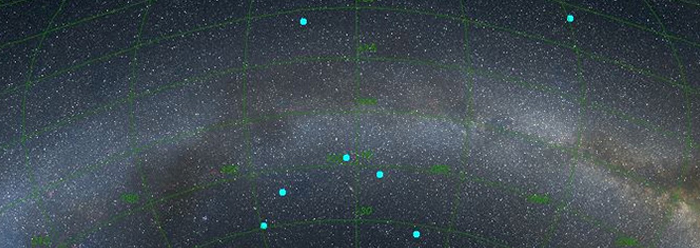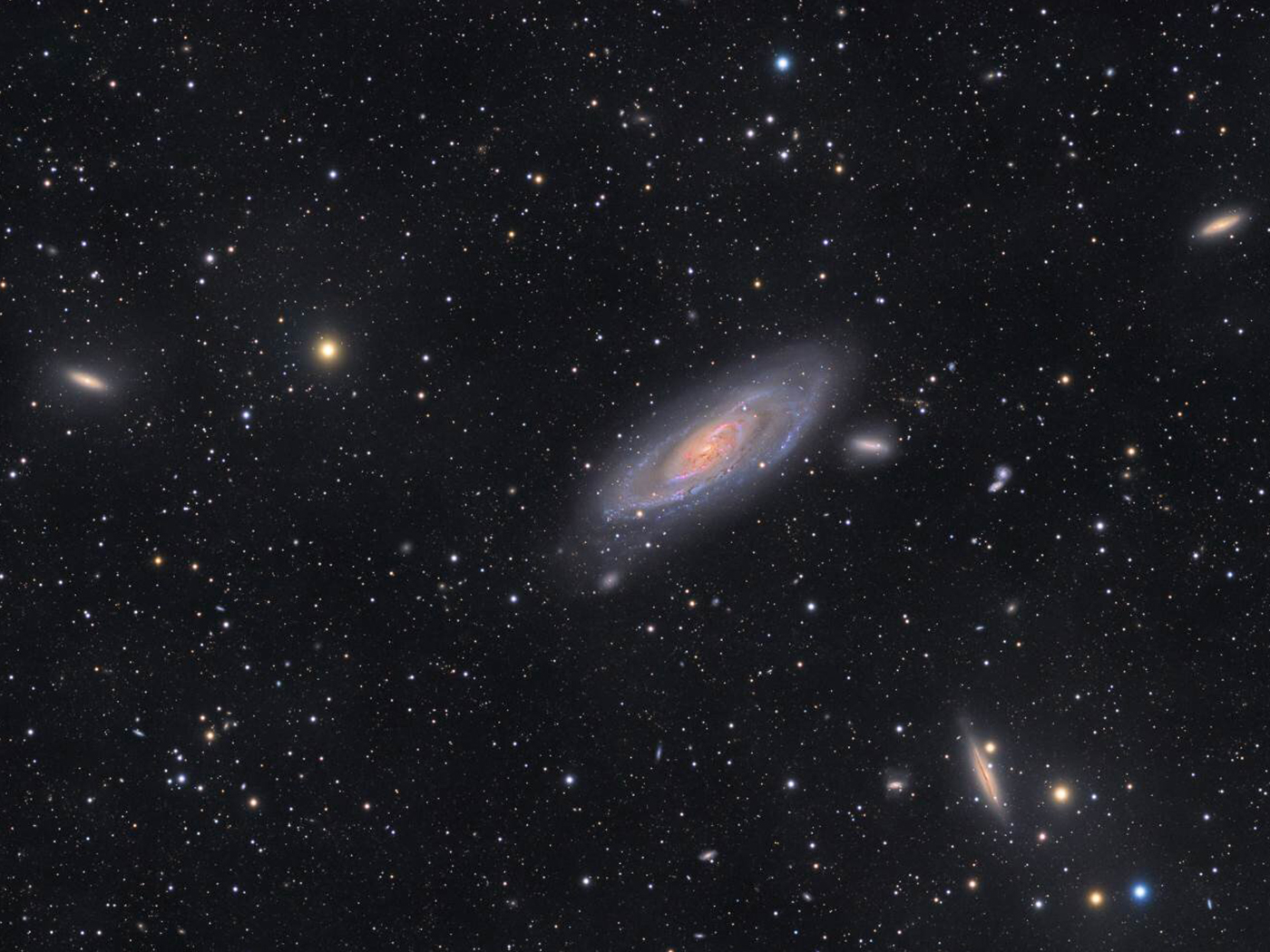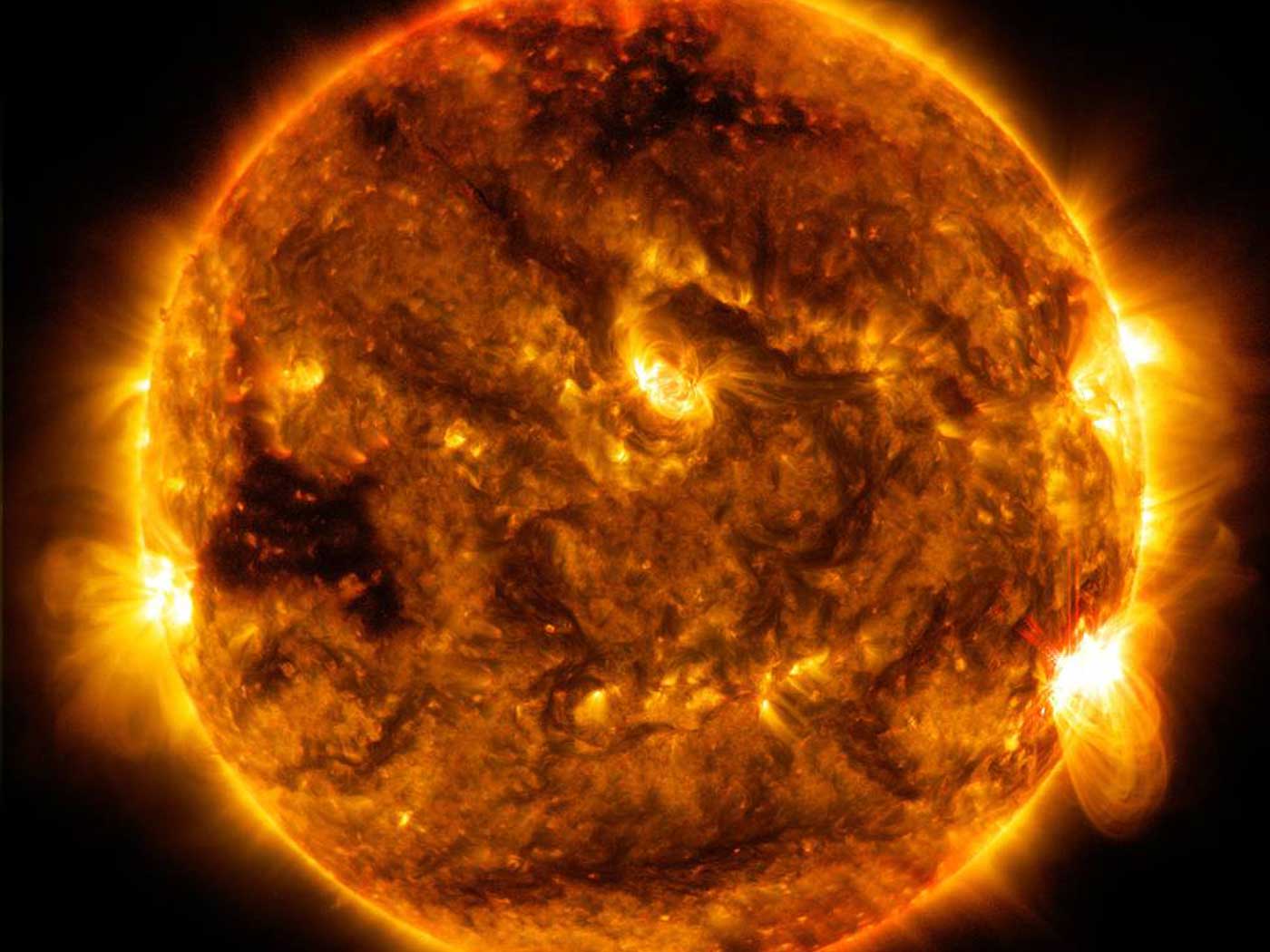A team of astronomers from Hungary and the United States, led by Professor Lajos Balázs of Konkoly Observatory in Budapest, has announced the discovery of an enormous ring of galaxies. According to the Big Bang model, this ring should not exist.1,2,3
The galaxies were identified from gamma-ray bursts (GRBs)—extremely intense, narrow beams of high-energy electromagnetic radiation which are thought to result from the collapse of high-mass stars. The astronomers estimated that the gamma-ray bursts originated in nine galaxies located approximately seven billion light-years from Earth. These galaxies are thought to be part of a ring of galaxies so large that it spans a very large portion of the sky—an area 70 times greater than the apparent diameter of the full moon. Despite this fact, the astronomers argue that the nine galaxies are almost certainly part of the same giant structure.
If they are correct, then this would imply the existence of a gargantuan ring of galaxies, although Balázs claims that the ring could also be the result of a spherical structure.3 Either way, the apparent structure is enormous—an estimated five billion light-years across.
The possible existence of this giant ring of galaxies is of great interest because it would violate one of the fundamental tenets of the Big Bang model, namely the assumption that matter and energy, on cosmic distance scales, are distributed uniformly in space. But such a uniform, or homogeneous, distribution of matter implies that giant structures, such as this ring of galaxies, should not exist.
The Big Bang model also assumes a property called isotropy, which means that, on the largest scales, there are no special directions in space. Together, homogeneity and isotropy comprise the so-called "cosmological principle." The cosmological principle is foundational to the Big Bang, because these assumptions were built into the model at the earliest stages of its development. Hence, for secular scientists to abandon any of these assumptions would not constitute a minor tweak to the Big Bang story. Rather, it would require a complete re-write!
While it might be possible for secular scientists to construct another version of the Big Bang model which does not require these assumptions, doing so would force them to abandon decades of work, and it would be a tacit admission that the Big Bang model, as it now stands, is an utter failure.
Yet, Balázs' team of astronomers acknowledged that this ring of galaxies, if real, is large enough to contradict the cosmological principle. They do leave some wiggle room for the cosmological principle at the end of their paper, claiming that the ring is "probably not a real physical structure."1 Yet this statement goes against the overall tenor of their paper and that of accompanying news reports. One can't help but wonder if Big Bang politics played a role in the inclusion of this statement in their paper. Balázs concludes, "If we are right, this structure contradicts the current models of the universe. It was a huge surprise to find something this big – and we still don't quite understand how it came to exist at all."3
Even if this ring should turn out not to be real, other giant structures problematic for the cosmological principle have already been discovered. Earlier this year we reported the possible existence of a giant "supervoid" which is also problematic (though perhaps not fatal) to the assumption of homogeneity.4 Moreover, two years ago scientists claimed to have discovered a collection roughly 1.6 billion light-years across of 73 extremely bright objects called quasars. This structure should not exist either if the cosmological principle is correct.5
Scientists have also reported the discovery of an immense collection of galaxy clusters estimated to be a whopping ten billion light-years across! This structure currently holds the record for the largest known structure in existence.6
The Big Bang is riddled with other serious problems, many of which have been discussed on our ICR website.7,8,9 Given these problems, one wonders why secular scientists (and even some Christians!) hold onto it so tenaciously. But since the Big Bang contradicts both the Bible's straightforward creation account in Genesis and our observations, why should anyone take it seriously?
References
- Balázs, L. G. et al. 2015. A giant ring-like structure at 0.78 < z < 0.86 displayed by GRBs. Monthly Notices of the Royal Astronomical Society. 452: 2236-2246.
- Massey, R. 5 billion light years across: the largest feature in the universe. News & Press, Royal Astronomical Society. Posted on ras.org.uk August 5, 2015, accessed August 10, 2015.
- O'Neill, I. Giant Mystery Ring of Galaxies Should Not Exist. Space.com. Posted on space.com August 7, 2015, accessed August 10, 2015.
- Hebert, J. A Cosmic 'Supervoid' vs. the Big Bang. Science News Update. Posted on icr.org May 7, 2015, accessed August 10, 2015.
- Wall, M. Largest Structure in Universe Discovered. Space.com. Posted on space.com January 11, 2013, accessed April 22, 2015.
- Klotz, I. Universe's Largest Structure is a Cosmic Conundrum. Discovery News. Posted on discovery.com November 19, 2013, accessed August 11, 2015.
- Thomas, B. Big Bang Fizzles under Lithium Test. Science News Update. Posted on icr.org September 22, 2014, accessed August 11, 2015.
- Thomas, B. Distant Galaxies Look Too Mature for Big Bang. Science News Update. Posted on icr.org November 30, 2011, accessed August 11, 2015.
- Hebert, J. 2012. Big Bang Explanations Fall Flat. Acts & Facts 41 (11): 16
Image Credit: 2015 NASA. Public domain. Adapted for use in accordance with federal copyright (fair use doctrine) law. Usage by ICR does not imply endorsement of copyright holder.
*Dr. Hebert is Research Associate at the Institute for Creation Research and received his Ph.D. in physics from the University of Texas at Dallas.
Article posted on August 24, 2015.
























